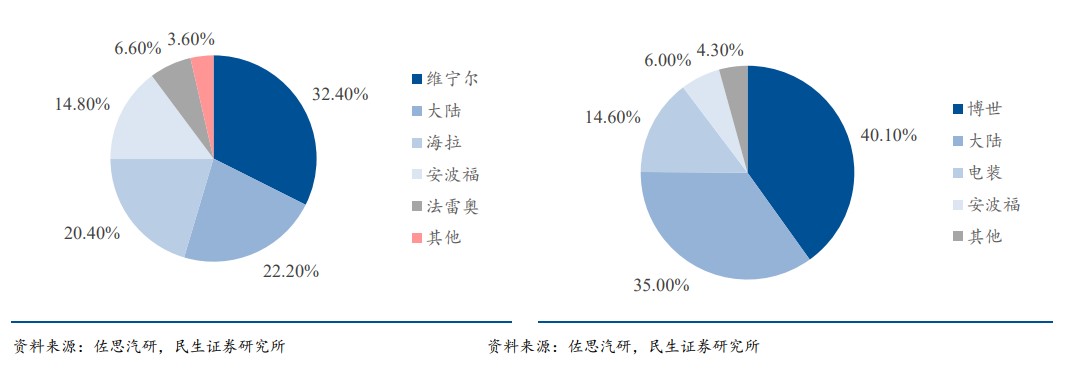As mentioned in the previous part, Minsheng Securities believes that in the field of multi-sensor, there are three kinds of radars that are gradually put on the car to strengthen the perception function. In the previous article, we introduced ultrasonic radar sensors, and then we will introduce millimeter-wave radar and lidar.
Millimeter-wave radar: domestic manufacturers are replacing high-frequency and integrated domestic products
Millimeter-wave radar is a high-frequency electromagnetic wave detection technology, whose wavelength is between microwave and light wave, and has excellent penetration and anti-interference ability. In the automotive industry, millimeter-wave radar is one of the key technologies in the era of intelligent driving, and is widely used in functions such as adaptive cruise control, forward collision avoidance, emergency braking assist, blind spot monitoring, and assisted parking. With the development of autonomous driving technology, the number of millimeter-wave radars, as the core sensors of environmental perception, is also rising, and the data for the first half of 2024 shows that the number of millimeter-wave radars has reached 10.679 million, an increase of 11.5% year-on-year.
Millimeter-wave radar emits a frequency modulated continuous wave (FMCW) through an antenna, and there is a time difference between the echo received after reflection by the target and the transmitted wave, and the target distance can be calculated by using this time difference. The frequency difference between the transmitted and reflected signals is analyzed by the signal processor, and the movement speed of the target relative to the radar can be accurately measured based on the Doppler principle, and the multi-target detection and tracking algorithm can be further used to realize the separation and tracking of multiple targets.

Figure: Block diagram of millimeter-wave radar for vehicles
In the field of autonomous driving, millimeter-wave radar is widely used by major automobile manufacturers due to its all-weather working ability, speed measurement accuracy and high cost performance. The supply of millimeter-wave radar in the Chinese market is mainly occupied by international radar manufacturers, but domestic manufacturers are also actively developing 4D imaging millimeter-wave radar to meet the development of the field of autonomous driving and the needs of complex scenarios. It is expected that by 2025, the number of 4D imaging radars will increase significantly, and it will become the mainstream configuration of new models of many car companies.
At present, the millimeter-wave radar market is mainly occupied by Tier1 manufacturers, of which the main market share of short-range millimeter-wave radar is composed of Veoneer (32%), Continental (22%), Aptiv (15%), Valeo (7%), and long-range millimeter-wave radar is mainly composed of Bosch (40%), Continental (35%), Denso (15%), and Aptiv (6%).

Figure: Market share of short-range mmWave radar in China's passenger car market (left) and long-range mmWave radar market share in China's passenger car market (right)
Domestic manufacturers in the millimeter-wave radar industry chain have achieved local breakthroughs in many links, especially in the localization of core components such as RF front-end components (MMIC), digital signal processors (DSP/FPGA), and high-frequency PCB boards. For example, representative companies such as Silicon Micro, Kida Technology, Calteran Micro, and Sijie Micro have launched mass-produced products, while Shennan Circuit, Shengyi Electronics, and Shanghai Electric Co., Ltd. have made technological breakthroughs in the field of high-frequency PCB, making product performance comparable to the high-end products of large foreign enterprises.
In addition, domestic midstream enterprises in the millimeter-wave radar industry chain, including millimeter-wave radar solution providers and system integrators, are also accelerating to catch up with international enterprises. The companies involved include Jingwei Hengrun, Desay SV, Weifu Hi-Tech, Huayu Automobile, Baolong Technology, etc., which are gradually expanding their market share in the supply of millimeter-wave radar solution modules and complete machines.
In terms of the development trend of millimeter-wave radar, 77GHz millimeter-wave radar is gradually becoming the mainstream of the market due to its smaller wavelength, wider frequency band and higher resolution, while 24GHz millimeter-wave radar is gradually replaced by 77GHz in performance. Domestic manufacturers have made breakthroughs in the R&D and mass production of 77GHz millimeter-wave radars, such as Sensitech, Huayu Automobile and other companies have begun to mass-produce 77GHz millimeter-wave radars, and the performance is close to the products of foreign manufacturers.
For more info:
The Road to Multi-sensor Fusion Begins (1)
The Road to Multi-sensor Fusion Begins (2)
The Road to Multi-sensor Fusion Begins (3)






